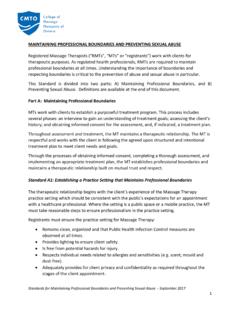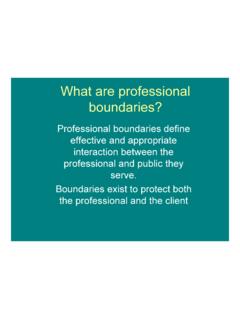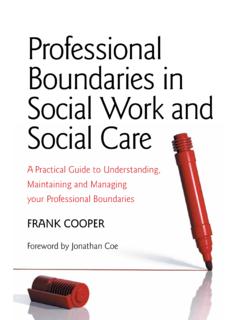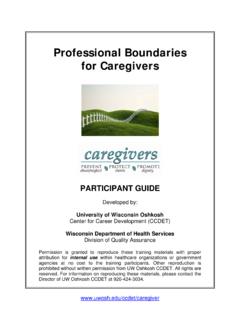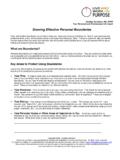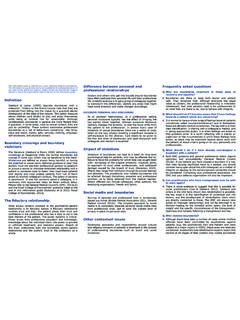Transcription of BOUNDARIES - Avalon Center
1 BOUNDARIES . Adapted from Iowa Coalition Against Domestic Violence Advocate Training Manual and MLT BOUNDARIES of Practice Guidebook NOTE. This presentation on BOUNDARIES is from the perspective of a staff person to a client, but the information is also applicable to a volunteer/client interaction. Defining BOUNDARIES BOUNDARIES are: Limits that allow for safe connections between individuals Limits on actions which Acknowledge the difference between the advocate's power and the client's vulnerability Prevent conflicts of interest Maintain safety for both parties in the relationship. Are based on context Can be complex and multi-layered. Defining Advocacy Advocates are trained to assist victims of crime. Advocates should: Recognize the interests of the client as a primary responsibility Respect the client's rights to privacy and confidentiality, subject only to laws or regulations requiring disclosure of information to appropriate other sources. Respond compassionately to each client with personalized services Accept the client's statement of events as it is told, withholding opinion or judgment, whether or not a suspected offender has been identified, arrested, convicted, or acquitted.
2 Provide services to every client without attributing blame, no matter what the client's conduct was at the time of the victimization or at another stage of the client's life Ohio Family Violence Prevention Center Advocate-Client BOUNDARIES Social relationships are for people who enjoy each others company and have shared interest, each party is equally responsible to establish and maintain the relationship and address power imbalances. Advocate-Client relationships are planned and goal-directed interactions between an advocate and an abuse survivor. Advocates need to recognize that: Advocates are responsible for maintaining and teaching appropriate BOUNDARIES . Sometimes a client's concept of BOUNDARIES can be so under- formulated that they may not be aware of what appropriate BOUNDARIES are. This is often because clients tend to be in crisis and their BOUNDARIES have been completely violated and ignored. Advocates need to empathize appropriately. Overstepping BOUNDARIES takes place when an advocate moves from caring about clients to becoming over involved in the clients' lives.
3 Also under-involvement with a client can be a boundary violation as well. Advocate-Client BOUNDARIES (continued). The advocate-client relationship is one of unequal power. The advocate has knowledge, access to resources, authority and influence the survivor needs. This creates vulnerability. The client can perceive boundary crossings as the misuse of power or the betrayal of trust. Boundary crossings can cause minor or major physical, emotional or economic harm to clients. Setting BOUNDARIES Protects the client Protects the advocate Protects the agency Promotes healthy interactions UNDERSTANDING. POTENTIAL. BOUNDARY CROSSINGS . All professionals commonly face situations that, if not managed properly, can quickly lead to excursions across BOUNDARIES . The situations are called potential boundary crossings . Boundary crossings can be inadvertent and unintentional. However, a potential boundary crossing, unchecked, can quickly lead to a boundary violation. A literature review reveals that most advocate-client boundary issues fall into four major categories of concern that can be seen along a spectrum of behavior that could be interpreted as appropriate, slightly inappropriate or in the worst case, criminal.
4 Four Major Categories of Boundary Issues Client care ( care as deemed appropriate by agency's policies and procedures which can deal with affection; respecting cultural differences, over-involvement or under-involvement with client, tone, communication, having adequate staff to meet client care ). Access to and/or disclosure of information ( federal and state privacy acts, code of ethics obligations related to patient confidentiality, professional misconduct for breaking patient confidentiality, local policies and procedures related to privacy, and inappropriate self etc.). Gifts, services and financial relationships ( understanding the motivation behind gift giving, respecting the timing of the gift and the cost of the gift, respecting client etc.). Dual relationships ( business relationships with client;. understanding when the client ceases to be a client; treating family etc.). RED FLAGS. DANGER ZONES. Acceptance or giving of gifts There are rarely black and white rules for BOUNDARIES .
5 Accepting small tokens of appreciation may be okay. You should refuse a gift when you think the survivor is doing it for other reasons such as to win special privileges, manipulate, or as a come-on. If possible, share the gift with other staff so that it is clear you are accepting for the whole agency. "I'll take these cookies to our staff meeting.". "Let's put the flowers here where everyone can enjoy them." It is sometimes acceptable to give small gifts to celebrate milestones. Try to make them relate to the survivor's safety or therapeutic goals, (a journal, a book on parenting, an alert whistle for her keychain). Giving gifts of minimal value may also help establish relationships with children or adolescents and it is often acceptable. Giving gifts under other circumstances is likely to be a boundary violation. Presence of conditions conducive to burnout Constant pressure to do more with less. Using work to satisfy all needs. Such issues create emotional stressors which can lead to unhealthy boundary choices.
6 RED FLAGS. DANGER ZONES. (continued). Lack of definition: job description, written policies & procedures Lack of defined procedures and lack of awareness of procedures can easily result in staff committing boundary violations. Sharing intimate personal information or work concerns with a client You should not develop friendship relationships with women while they are using your agencies services. Friendship implies mutual support. You should not meet your own personal emotional needs within the advocacy relationship. The power in the relationship is not equal. Making your own rules Altering your limits. Seeing yourself as unique or above the rules or victimized, unsupported, or misunderstood. RED FLAGS. DANGER ZONES. (continued). Promising particular clients loyalty/availability/special treatment Showing favoritism with clients can not only undermine the healing process of other clients but the client being favored as well. Allowing a client to believe they can circumvent rules or BOUNDARIES teaches them unhealthy BOUNDARIES and fails to facilitate learning coping skills they need to develop when things may not proceed as they planned or desired.
7 Having dual relationships If you knew the survivor in some other way before she became a client (friend, coworker, relative, etc.) you should take extra care to maintain your BOUNDARIES . Best practice is to transfer advocacy to a coworker or other project at the first opportunity. Advice giving Telling someone what they should do plays up the power differential between you, may be judgmental, and is disempowering. Your role is to provide information, including your previous experience with systems, not to recommend a particular course of action. You should certainly explore likely outcomes. RED FLAGS. DANGER ZONES. (continued). Reversal of roles You may find that some of the survivors you work with have specialized skills or knowledge that you personally would benefit from, or that you desire support. It is inappropriate to get those needs met from the survivors you are or your agency is working with. Such dual relationships confuse and blur relationship BOUNDARIES . If you find yourself needing support or assistance seek outside help.
8 Over-identification and frequently thinking of a client when away from work The I-know-how-you-feel" reaction can be helpful but is just as likely to convince your client of the complete opposite. She may respond with, No, you don't! . Attempts to develop rapport with the survivor by pointing out superficial similarities between your own and her experiences may be interpreted as your desire to talk about your own problems. Working with survivors of violence can bring up many painful personal issues. If you find it hard to keep the focus on your clients or if brooding about work intrudes on your personal life, make sure you process these issues with your co-workers and/or seek professional support for your needs RED FLAGS. DANGER ZONES. (continued). Keeping secrets with a client If you hide your interactions with your clients or your actions on their behalf from your co-workers, there is usually a reason: at some level BOUNDARIES are being violated, you are breaking agency policy, etc.
9 If you feel that the policy is harmful to a client that is a discussion to have with your fellow staff. You may have identified a policy that needs to be changed or done away with. If you believe that keeping secrets with a client shows that you are trustworthy, be aware that it often proves just the opposite. It lets her know that you are not to be trusted because you will break the BOUNDARIES set up by agency policy. If you don't obey the rules, then no rules for human interaction can be trusted for sure. Spending free time with a client This blurs the line between advocacy and friendship. You will like and enjoy many of the women you advocate for, but it is not helpful to violate BOUNDARIES on their behalf. It changes the terms of the relationship. You will be more likely to favor one client over another. You will also be more likely to rely on the client to meet your own needs. RED FLAGS. DANGER ZONES. (continued). Withholding knowledge or advocacy from a client as a punishment or to coerce compliance Like everyone else, some battered women have difficult, draining, frustrating, or irritating personalities.
10 It may be tempting to offer fewer services or resources to coerce battered women into courses of actions that you would prefer they take or simply into being easier to work with. All clients should have equal access to information and support, even the difficult ones. Getting entangled in the RESCUE TRIANGLE. The Rescue Triangle describes an unhealthy relationship that can develop between advocates and clients which can affect application of appropriate BOUNDARIES . The three roles of the triangle are interchangeable. In some cases, a person may be the Victim or the Persecutor, and in others the Rescuer or the Persecutor RED FLAGS. DANGER ZONES. (continued). RESCUE TRIANGLE. RESCUE TRIANGLE. DEFINITIONS. The Victim This person is in a "one-down" position and believes that she is powerless to change either herself or the situation, this person is the Victim. Our victims are often in crisis and expect the Rescuer to assume the responsibility for the helping process. The Rescuer When advocates view the person being helped as powerless they become the Rescuer.

